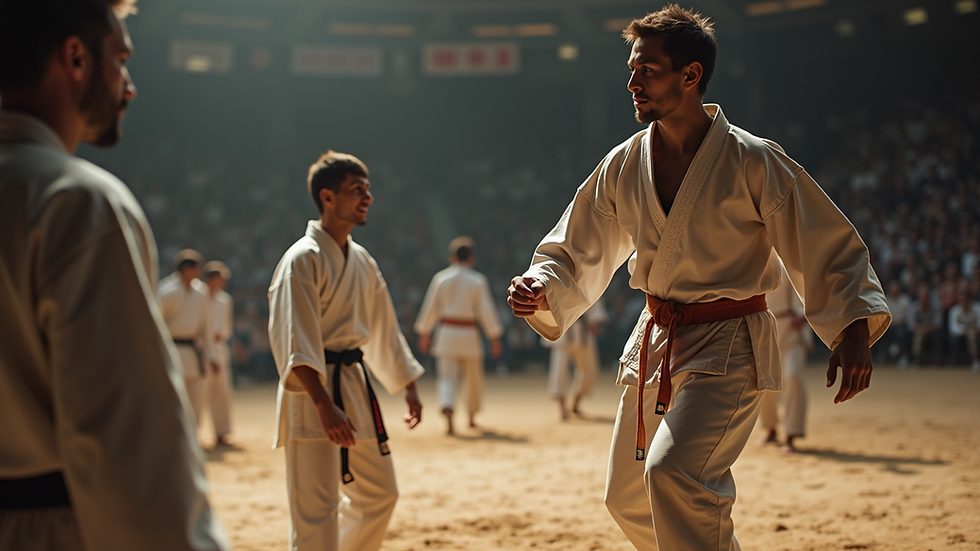Discover the Fundamentals of Kenpo and its Benefits
- Sifu Camp

- Jun 23
- 4 min read
Kenpo is not only a martial art; it is a way of life that promotes physical fitness, mental discipline, and self-defense skills. Originating in Japan and later evolving in the United States, Kenpo combines both traditional and modern techniques to create a comprehensive self-defense system. In this blog post, we will explore the fundamentals of Kenpo, detailing its benefits and what you can expect from training.
Kenpo Basics
Kenpo is a dynamic martial art that emphasizes quick, powerful strikes and fluid movements. It incorporates techniques from various martial art styles, including karate and jujitsu. The beauty of Kenpo lies in its adaptability; students learn how to respond effectively to various combat situations.
The foundation of Kenpo revolves around several key principles:
Striking: This includes punches, kicks, elbows, and knee strikes. The goal is to deliver powerful blows while maintaining balance and control.
Blocking: Understanding how to block or deflect an opponent's strikes is crucial. Kenpo emphasizes defensive techniques, ensuring practitioners can protect themselves.
Joint Locks and Throws: These techniques allow a student to immobilize or throw an opponent. They provide an effective means of control in a self-defense scenario.
Footwork: Fluid footwork helps maintain balance while transitioning between strikes and defensive moves. Understanding foot placement is essential for executing techniques effectively.

Training in Kenpo can be conducted in various environments, including traditional dojos and modern online platforms. Online resources, such as virtual kenpo, make it easier for beginners to get started, providing instructional materials and virtual classes to learn at their own pace.
Benefits of Kenpo Training
Engaging in Kenpo offers numerous physical, mental, and emotional benefits:
Physical Fitness
Kenpo training is an excellent workout that improves strength, stamina, and flexibility. The diverse range of techniques challenges muscles in various ways, promoting overall fitness. Regular practice can help individuals:
Build core strength and muscle tone
Improve cardiovascular health
Enhance coordination and agility
Confidence and Discipline
Training in Kenpo fosters self-confidence and discipline. As practitioners progress through different levels, they overcome challenges and develop skills that translate to other aspects of life. This boost in self-esteem can lead to:
Improved public speaking skills
Better interpersonal interactions
Enhanced focus on personal goals
Self-Defense Skills
One of the primary reasons people choose to learn Kenpo is for self-defense. The practical techniques taught in Kenpo provide essential skills to protect oneself in potentially dangerous situations. Key benefits include:
Ability to recognize and avoid dangerous situations
Techniques for escaping a hold or a threat
Building awareness of surroundings and potential risks
Mental Acumen
In addition to physical abilities, Kenpo promotes mental sharpness. The intricacies of techniques require focus and concentration, which can sharpen cognitive skills. Benefits include:
Improved memory and problem-solving skills
Increased mental clarity and stress relief
Enhanced decision-making abilities in high-pressure situations

How Long Does It Take to Learn Kenpo?
The time it takes to learn Kenpo greatly depends on individual goals and the commitment to training. Generally, students can expect to achieve basic proficiency within 12 to 18 months of regular practice. Reasons for this timeframe include:
Class Frequency: Attending classes at least two to three times a week can significantly accelerate learning.
Practice Outside Class: Students who dedicate time to practice outside of class can grasp concepts more rapidly.
Instructor Guidance: Quality instruction plays a vital role in understanding the intricacies of techniques and philosophies.
As practitioners progress, they can earn colored belts that signify their level of training. This progression can take anywhere from a couple of months to several years, depending on the individual's dedication and the dojo's curriculum.
Community and Camaraderie
Another benefit of Kenpo is the sense of community that forms among practitioners. Kenpo schools promote camaraderie and teamwork, enabling students to build friendships while working towards a common goal. Some aspects include:
Shared Experiences: Training together fosters a supportive environment where students help each other grow.
Group Activities: Many Kenpo schools organize tournaments, social events, and seminars, enhancing the sense of community outside the dojo.
Supporting one another allows students to stay motivated and accountable, making the journey of learning Kenpo more enjoyable.

Final Thoughts on Kenpo
Learning Kenpo is more than just mastering self-defense techniques—it is a holistic approach to physical and mental well-being. The integration of practical skills, fitness, confidence-building, and community creates a unique experience that enhances everyday life. Whether you are looking for a way to get in shape, boost your self-esteem, or learn how to defend yourself, Kenpo offers numerous benefits that can empower you.
As you contemplate your journey in martial arts, consider exploring resources like virtual kenpo for a convenient way to begin or advance your training. With time, commitment, and practice, the fundamentals of Kenpo can lead to lasting benefits that reach far beyond the dojo.



Comments